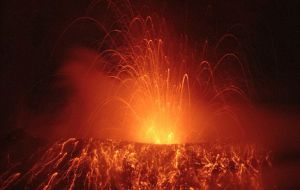MercoPress. South Atlantic News Agency
Ecuadorean volcano spews red-hot rock and ash; populations abandon risk area
 “Throat of fire” activity has sent alert level from yellow to orange (Photo credit AP)
“Throat of fire” activity has sent alert level from yellow to orange (Photo credit AP) Ecuador's Tungurahua volcano (‘throat of fire’ in indigenous Quechua language) spewed red-hot rock and ash Tuesday as officials upgraded their eruption warning level to orange and some at-risk communities began evacuations.
The 5,029-meter volcano in the country's central Andes, about 135 kilometres south of the capital Quito, has been active since 1999 but its thermal activity has steadily increased since Sunday, sending pyroclastic boulders into the air and cascading down from the summit.
Good weather prevailed on Monday night, allowing scientists to observe “the continuous output of incandescent material,” the Geophysical Institute said in its latest report. “This activity was characterized by the expulsion of incandescent boulders, rising more than 300 meters above the crater and rolling down all sides of the volcano.”
The increased activity prompted authorities to raise the alert level from yellow to orange, just below the highest alert level or red, in the impact zone which includes several communities on the volcano's slopes, according to the Ecuadorean National Secretariat for Risk Management (SNGR).
Authorities have inspected and prepared shelters ahead of possible evacuation orders, while the military and police were being told to coordinate efforts in the area, SNGR said.
“Given the level of alert, populations located in risk areas such as Cusua, Juive, Palictahua and Manzano voluntarily evacuated to safer locations,” the relief agency said Monday.
The Geophysical Institute on Tuesday recommended people leave high-risk areas “because the current eruption process began abruptly and has generated several pyroclastic flows that have affected the upper flanks of the volcano.”
Several communities in the shadow of Tungurahua, including the tourist town of Baños with 15,000 people, were forced to evacuate during the volcano's violent eruption in 1999. Residents could only return to their homes one year later.




Top Comments
Disclaimer & comment rulesCommenting for this story is now closed.
If you have a Facebook account, become a fan and comment on our Facebook Page!